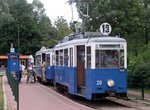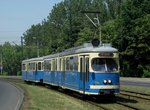Krakow, Poland
![]()
Ex-Vienna Type E1 116 at Kombinat, Krakow. Photo by Tim Deakin.
Overview
Krakow, Poland's second largest city, features a large tram network which forms the backbone of the area's public transport network. Whilst a small number of bus routes also penetrate the beautifully-restored central area, the rubber-tired vehicles play second fiddle to trams, many bus routes acting as 'feeders' from outlying areas to tram stops. Krakow's tram fleet is, by the standards of that operated in several Polish cities, varied, and includes many second-hand trams acquired from Austria and Germany.
The tram network is extensive and serves most areas of the city. All outer terminals are served by at least two routes, and all consist of large turning loops as the fleet is entirely single-ended. Trams are busy and fares are - by Western standards - low. Whilst most running away from the central area is on reserved track, much of that in the CBD takes place on street trackage. Of particular interest is the network around Nowa Huta, a new town dating from the 1950s, built around a huge steelworks to the north east of the Krakow area. Some of the track in Nowa Huta and its vicinity passes through very rural, tree-lined rights-of-way, particularly the sections between Kombinat and Kopiec Wandy, and that between Wiaducty and Wzgorza Krzeslawickie. Wiaducty is of special note in that it's a large triangular junction set amidst fields on two sides!
Nowa Huta is also of note in being served by four of its own internal tram services, lines 16, 17, 20 and 21. None come remotely close to Krakow's city centre, and two only run sporadically.
Undoubteldy the most common type of car in the fleet is the Konstal 105N model and its derivatives. This is very similar externally to several of Czech tram manufacturer Tatra's late-20th century range; the reason for this is that Poland took delivery on a Tatra car and simply copied it! Konstal's factory, at Chorzow, churned out hundreds of these cars for all the major Polish tram systems during the 70s, 80s and 90s.
Krakow operates a few hundred, built between 1975 and 1985, and most are operated in two-car sets. Exceptions from the rule are those used on infrequent line 18 (Cichy Kacik-Lagiewniki) and line 20, which sporadically operates between Mistrejowice and Kopiec Wandy in the north-west of the city, avoiding the central area altogether. Both these lines operate single cars. Furthmore, busy lines 4 and 13 operate triple sets of 105Ns, although two-car sets are used on both at weekends. The vast majority of trailing cars have cabs, presumably for use when shunting in depots, although as is usual with East European tram cars used in this manner they lack windshield wipers and rear view mirrors. A small number lack driving positions altogether, however.
The other type of car in the main fleet which was purchased new is a number of Bombardier's NGT6 low-floor articulated model. These operate on lines which serve the Kurdwanow terminus in the south of the city, although at weekends they also seem to be used elsewhere.
There are two batches of second-hand trams operated. First to be acquired was a batch of MAN GT6 articulated cars, purchased from Nuremburg in Germany. Also purchased with these cars was a batch of trailers, although not all sets are used with a trailer attached. These cars - which date from the early- to mid-1960s - are concetrated in the Nowa Huta area of Krakow, and only penetrate the central area on lines 22 and 72, of which the latter is a temporary route whilst a certain section of trackage is out of service. Trailer operation is only practiced on route 22, with all the other MAN-operated lines in the city being served by single articulated units. Other lines where the MANs may be found are routes 16, 17 and 21, which operate in the Nowa Huta district and stay clear of the central area. Despite their age, they are in excellent condition and should remain in use for several years yet.
The other batch of second-hand cars is a number of Duwag E1 articulated units purchased from Vienna. In the traditional Vienna style, they look very well in Krakow's attractive blue and cream livery; one retains Vienna's red and white livery. Also acquired were a number of trailers, and the majority of E1s in use tow one. The exception is temporary route 72 described above, which has a requirment of three articulated units without trailers; it is shared between the ex-Vienna Duwags and the ex-Nuremburg MANs. The E1s have complete charge of busy line 1 (Salwator-Wzgorza Krzeslawickie), and also operate on line 14 (alongside Konstal 105s) and 22, complementing the second-hand MANs. Whilst line 1 sees trailer operation every day, such operation on lines 14 and 22 is limited to weekdays. As with their German cousins, the condition of the ex-Vienna cars belies their age and they are somewhat more refined than the newer Polish trams in use.
Also retained by the city's transport operator, MPK Krakow, are a number of 'heritage' tramcars. Whilst many other undertakings are content to let their supposedly preserved cars sit and deteriorate, MPK Krakow commendably operates two sets of theirs in public service every Sunday during the summer. They are used on quiet line 18 and may be ridden for nothing more than the cost of a normal ticket. To be found in use on this venture are a strangely-styled Konstal 102N articulated unit; an example of its updated but similar 102Na brother; and two sets of ancient Polish four-wheel trams, both of which operate as motor and trailer sets and have hand-operated doors. Also retained is a motor-and-trailer set of MAN cars, to a similar design as the articulated units still in the front line fleet. Condition of these preserved units is excellent, and they are accompanied by a team of volunteers who dispense small fact-sheets and copious information about the trams themselves.
Krakow is, by any railfan's standards, worth a visit. Apart from a varied, well turned out tram fleet, the city also has some spectacular architecture and a very well-preserved medieval central area. There is also a lot of heavy rail activity in the area, and Krakow is within easy reach of both the Czestochowa and Silesian Interurban tram systems.
Photo Gallery
| Five Random Images | ||||
 Image 51384 (125k, 720x540) Photo by: Tim Deakin Location: Cichy Kacik |  Image 51413 (136k, 720x540) Photo by: Tim Deakin Location: ul. J. Dietla |  Image 51417 (136k, 720x540) Photo by: Tim Deakin Location: Hala Targowa |  Image 51437 (135k, 720x540) Photo by: Tim Deakin Location: Kombinat |  Image 51448 (116k, 720x540) Photo by: Tim Deakin Location: Mistrejowice |
Page Credits
By Tim Deakin.